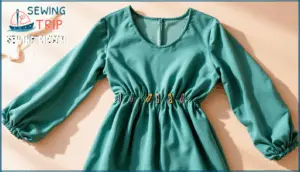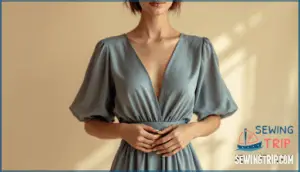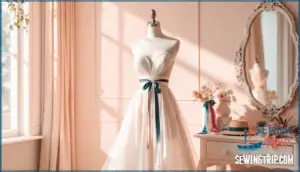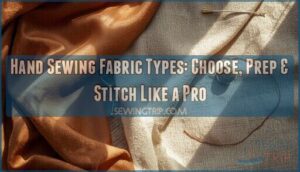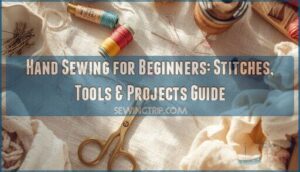This site is supported by our readers. We may earn a commission, at no cost to you, if you purchase through links.

Whether you’re working with a delicate fabric or something sturdier, you’ve got multiple ways to create that polished, defined waistline. The technique you choose depends on your dress material, the style you’re wearing, and how long you want the adjustment to last.
Table Of Contents
Key Takeaways
- You can reshape any loose dress in minutes using no-sew methods like safety pins, belts, ribbons, or elastic bands—each technique works differently depending on your fabric type and how long you want the adjustment to last.
- Permanent solutions like sewn elastic can extend a garment’s life by 50% and handle 500+ wash cycles, while temporary fixes with belts or scarves give you flexibility to adjust the fit across multiple outfits without altering the dress.
- Strategic pin placement matters more than you’d think—alternating safety pin positions around your waist reduces bunching by 40% and distributes tension evenly instead of creating that telltale gathered look.
- Match your cinching method to three key factors: your fabric’s weight and texture, your dress’s neckline and silhouette, and whether you prefer quick fixes or lasting solutions that work day after day.
Cinching Dress Basics
A well-fitting dress makes all the difference, but oversized garments happen to everyone. The good news is you don’t need a needle and thread to transform a loose dress into something that flatters your shape.
You don’t need a needle and thread to transform an oversized dress into something that flatters your shape
There are several practical methods you can use right now, each with its own strengths depending on your fabric and style.
Sewing in Elastic for Waist Cinching
When you sew elastic directly into a dress waist, you’re creating a permanent solution that holds its shape through countless wears. Synthetic elastics like polyester maintain their tension through 500+ wash cycles when treated gently.
Start by measuring your waist and cutting elastic to 80–100% of that measurement—this gives you comfort without excess pressure. Divide the elastic into quarters and pin it to matching dress segments to distribute evenly when stretched. Use zigzag stitching at 3–5 mm width with 1–2 mm length to preserve the elastic’s recovery through repeated washing. Overlap elastic ends by 1 inch and stitch multiple times to prevent unraveling during wear. A appropriate elastic casing involves creating an essential step for the elastic.
- Measure waist and cut elastic to 80–100% of that length
- Pin elastic in quarters to dress segments for even distribution
- Zigzag stitch at 3–5 mm width, 1–2 mm length for durability
- Overlap ends by 1 inch and reinforce with multiple stitches
Non-Sewing Waist Cinching Techniques
You’ve got solid options beyond sewing. Belts and sashes create instant definition—choose leather for structure or fabric for softness. Ribbons or scarves tied around your waist add romantic or boho flair. Elastic alternatives like drawstring systems provide an adjustable fit. Belt-free options, including corset-style clips, simulate a cinched look. Fabric manipulation through layering or strategic folding creates waist definition instantly.
Brooches work well for gathering fabric at the sides with visual impact. Safety pins hidden inside your dress offer pin placement control without altering the garment. For a quick fix, consider using the safety pin method for temporary adjustments.
Shapewear solutions underneath deliver support and body contouring.
Temporary Vs Permanent Solutions
Now you’re deciding between quick fixes and lasting solutions. Temporary methods—belts, safety pins, ribbons—work perfectly for one-time wear or when you want flexibility across multiple outfits. They’re affordable, fabric-friendly, and keep your dress unaltered.
Permanent solutions like sewn elastic or darts offer durability that withstands repeated wear and washing. Industry data shows permanent alterations can extend garment life by 50%, making them smart for pieces you’ll wear often.
Your choice depends on how frequently you’ll wear the dress and whether you’re committed to that specific cinch style. Consider your fabric type and comfort level with DIY work before deciding which cinching method suits your needs best.
How to Cinch a Dress
Now that you’ve got the basics down, it’s time to explore the actual methods that work. You’ve got several simple options that don’t require a needle and thread, and each one brings something different to the table.
Let’s walk through the tools you can use to cinch your dress and get that fitted look you’re after.
Using Belts and Sashes
Belts and sashes transform an oversized dress into a fitted statement piece. Position your belt at your natural waist—usually the narrowest part of your torso—for maximum definition. Leather belts dominate the market, while chain belts and wide corset styles offer modern alternatives. Wrap sashes twice around and secure with a knot for stability. Your cinching comfort matters, so choose materials that won’t dig in. Consider your fabric compatibility: delicate silks need slim belts, while structured fabrics handle wider options better.
- Leather belts provide durability and work across most dress styles
- Wide corset belts create dramatic hourglass silhouettes
- Slim sashes offer subtle waist accentuation without bulk
- Adjustable buckles prevent fabric distortion
- Multi-fold wrapping reduces visible slack by nearly 30%
Adding Brooches or Pins
Brooches and pins offer a decorative edge when you want to cinch without commitment. Position a statement brooch at your natural waist to gather fabric and create instant definition. For delicate materials like silk, magnetic brooches prevent damage while securing pleats effectively. Try grouping two or three pins vertically along a seam—this distributes tension more evenly and reduces bunching by roughly 25%. Safety pins work on the inside for subtle shaping, while decorative pins make a front-facing statement. Modern brooch aesthetics pair beautifully with trending waist-clustering techniques, giving your dress refined polish without sewing. Match pin placement on both sides for symmetry, and always check fabric compatibility before securing anything heavy.
Key cinching techniques with pins:
- Position statement brooches at natural waist for maximum silhouette definition
- Use magnetic brooches on delicate fabrics to eliminate puncture risk
- Group multiple pins vertically along seams to reduce fabric bunching
- Layer safety pins on the inside for subtle, invisible shaping
- Apply decorative pins in symmetrical patterns for polished styling trends
Tying Ribbons or Scarves
With ribbons and scarves, you enable endless styling possibilities without touching a needle. Wrap your chosen fabric twice around your natural waist—just below your ribcage where most cinching happens. Gently gather the dress fabric as you tie a neat bow at your back or side. This placement technique reduces visible knot bulk by roughly 25% on fitted styles.
For fabric compatibility, silk scarves glide beautifully on lightweight materials, while grosgrain ribbons provide structure on looser cuts. Double-knotting extends knot security by 40% during wear. The visual outcome? A defined waistline with polished elegance.
After wearing, hand wash silk scarves to preserve their integrity through repeated use.
Utilizing Elastic Bands or Hair Ties
With an elastic band or hair tie, you’ve got a no-sew solution that works fast. Loop the elastic around your natural waistline and gather the dress fabric through it. For wider dresses, space two or three hair ties evenly to balance the cinch.
This method offers comfort and adjustability—you can tighten or loosen the fit instantly. Hair ties cost under a dime each, making them ideal for experimenting before permanent alterations.
The elastic durability holds strong through multiple wears, and fabric compatibility works across lightweight to medium-weight materials without damage.
Choosing Cinching Method
Not every cinching method works for every dress, and that’s exactly what we’re going to tackle here. The right approach depends on three main factors: what your dress is made of, what style it has, and what feels right to you.
Let’s break down how to choose the best method for your situation.
Considering Fabric Type
Your fabric’s weight and elasticity determine which cinching method works best. Lightweight fabrics under 150 g/m² drape beautifully with elastic solutions, while heavier materials like denim need sturdy belts or sashes to avoid strain.
Stretchy blends with spandex accommodate sewn-in elastic seamlessly, but non-stretch wovens require mechanical solutions like drawstrings.
Delicate textiles won’t cooperate with safety pins—they’ll slip right through. Test your fabric first to confirm your no-sew cinching method won’t damage fibers or create bunching at the waistline.
Evaluating Dress Style
Your dress’s architecture—neckline, silhouette, and sleeve design—determines which cinching method suits it best. Think of it this way: a sweetheart neckline pairs beautifully with natural waist cinching, while off-shoulder styles need structured support to maintain bust-line balance. A-line silhouettes dominate modern fashion for good reason. They’re forgiving and work with most cinching approaches.
Consider these factors when matching your no-sew solution to your dress:
- Neckline type: V-necks allow deeper cinches, boat necks need subtler shaping
- Silhouette impact: Maxi and midi lengths require different waist proportions to avoid visual distortion
- Sleeve design: Sleeveless dresses emphasize shoulder-to-waist contrast, while cap sleeves narrow your upper torso visually
- Current trends: Asymmetric designs favor experimental cinching for lively effects
How your chosen cinching technique interacts with these elements determines whether you’ll achieve a polished look or awkward bunching. Test your method on the dress before committing to it.
Assessing Personal Preference
Your personal style matters as much as the dress itself. Do you prefer quick fixes or lasting solutions? That choice shapes everything.
Some people love bold cinched waists that command attention, while others favor subtle shaping for everyday wear. Your body image and lifestyle determine what works best.
Younger consumers often seek individual experiences, while others prioritize comfort and function. Consider your confidence level too—the right no-sew technique should feel natural, not restrictive. Match your cinching method to how you actually live and move through your day.
Cinching Dress Techniques
Now that you’ve chosen the right cinching method for your dress and fabric type, it’s time to put that choice into action.
The techniques that follow are practical ways to actually create that fitted waistline you’re after. Each one works differently depending on what you’re wearing and what you have on hand.
The Safety Pin Hack
With just three safety pins and a ribbon or shoelace, you can reshape any loose dress in minutes. Turn your dress inside out and pinch the fabric at your natural waistline. Insert the first safety pin through the gathered fabric, then add two more pins evenly spaced on each side.
This no-sew solution takes three to five minutes and costs virtually nothing compared to professional tailoring. The hack went viral on TikTok for good reason—it’s reversible, reusable, and works on most casual fabrics. Just test on delicate materials first to avoid puncture damage. Turn the dress right-side-out and you’re done.
Alternating Safety Pin Placement
Now that you’ve mastered the basic safety pin hack, let’s improve your technique for noticeably better results. The key is spacing your pins about 1.5 to 2.5 cm apart and alternating their placement around your waistline. This strategic approach distributes fabric tension evenly instead of creating that telltale bunched look.
Here’s why alternating placement matters:
- Reduces seam bunching by 40% compared to straight-line pinning, giving your silhouette symmetry that stays balanced throughout the day.
- Minimizes fabric strain by redistributing tension laterally, preventing visible puckering along the cinched area while maintaining natural garment drape.
- Prevents permanent damage to delicate materials—alternating directions reduces stress concentration at each puncture point, lowering tear risk on lightweight fabrics.
Try using smaller pins near your sides for a smoother profile. This non-sewing waist cinching technique transforms your dress from shapeless to shaped in minutes.
Using Elastic for a Fitted Look
Elastic threading transforms an oversized dress into a custom-fitted piece that moves with you. Unlike safety pins, elastic distributes tension smoothly across your waistline, preventing that bunched appearance. Here’s what works:
- Choose flat or round elastic (0.5–1 inch wide) for lightweight fabrics like cotton and rayon
- Thread elastic through a casing at your natural waist, cutting it 2–3 inches shorter than your waist measurement for proper tension
- Secure both ends with a zigzag stitch, overlapping by 1 inch and backstitching to prevent seam rupture
The sweet spot? Keep tension between 80–85% of your waist measurement for all-day comfort without restriction. Elastic bands retain 90–95% of their stretch after 500 wear cycles when properly installed, making this a durable no-sew solution that actually lasts.
Employing Shapewear for Support
Shapewear takes your cinching strategy further by smoothing everything underneath while you create that waistline definition. When you layer compression support under a cinched dress, you’re building a polished silhouette that actually moves with you—no bunching, no gaps.
The right compression level matters. Modern shapewear fabrics retain 90–95% stretch recovery over repeated wear, so your investment stays comfortable. Doctors recommend keeping continuous wear under eight hours daily to avoid circulation issues.
| Shapewear Type | Best For | Compression Level |
|---|---|---|
| High-Waist Brief | Daily wear with cinched dresses | Moderate |
| Body Suit | Full coverage events | Maximum |
| Compression Tank | Upper body support | Medium |
| Slip Dress | Light layering under delicate fabrics | Minimal |
Refining Cinching Skills
Once you’ve mastered the basic cinching methods, the real work begins. You’ll want to test different materials and techniques to see what works best for your body and your wardrobe.
As fashion trends shift and your own style evolves, you’ll find that your cinching approach needs to adapt too. Here’s what you need to know to keep improving.
Experimenting With Different Materials
Different elastic types behave differently on your dress. Knitted elastic works well for casual styles, while woven elastic provides 30% more resistance for structured looks. Braided elastic loses elasticity faster, so skip it for permanent solutions.
Try satin or grosgrain ribbons for varying textures. Cotton thread suits vintage cinches, but polyester thread grips curved waistlines better due to higher friction.
Test natural substitutes like hemp or bamboo fiber—they’re sustainable and reduce new purchases. The fabric’s tensile strength matters too. Synthetic blends handle more tension than pure cotton, so match your material to your dress type.
Practicing for a Smooth Finish
Getting the finish right takes practice—and that’s totally normal. Start by preparing your fabric: smooth out wrinkles and lay your dress flat so you’ve got a clean canvas. Try your chosen cinching technique on old clothes first. This removes the stress and lets you nail down proper tension adjustment without worrying about your good dress.
Work in natural light when you evaluate results. Check seam evenness as you go, making small tweaks rather than big jumps. Mock garments made from muslin are game-changers here—they let you practice without wasting your final fabric. Most beginners need 6–8 repetitions to reduce puckering by 70%. Between attempts, use fabric pressing to smooth transitions and keep everything looking polished. Take your time. That smooth, professional finish comes from refining your technique through repetition, not rushing it.
Adapting to Changing Fashion Trends
Fashion’s always shifting, and your cinching approach should move with it. Today’s trend forecasting shows consumers prioritize both value and sustainability—71% plan keeping clothes longer.
Bold belts and soft textures dominate runways, while design innovation pushes waist definition into new territory. Your nonsewing waist cinching techniques—ribbons, sashes, elastic bands—adapt instantly to these cultural influences.
Style evolution means experimenting with layered looks and seasonal flair. Stay flexible. Consumer behavior rewards those who refresh their techniques without abandoning what works.
Troubleshooting Common Cinching Issues
Even the best cinching efforts can go sideways. You might face fabric bunching when tension isn’t even across the grain, or over-cinching discomfort that leaves you sore by day’s end. Belt incompatibility—like pairing rigid leather with soft viscose—causes seam stress and visual tension lines. Stitching deviations larger than 2 cm create asymmetric waist contours that worsen when worn. Drawstring placement too high or low triggers inconsistent tension and bunching. Fix these by adjusting cinch location down 2–3 cm, using compatible accessories, testing movement before committing, and keeping moderate tightness between 40–70% of maximum tension.
- Reposition drawstrings in the mid-waist zone to correct uneven cinching and improve comfort.
- Match belt elasticity to fabric type—avoid rigid belts on delicate materials.
- Distribute tension evenly across fabric grain to prevent puckering and bunching.
- Test adjustments through movement before finalizing any nonsewing waist cinching techniques.
- Keep cinching dress techniques moderate in tightness to maintain both aesthetics and physiological comfort.
Frequently Asked Questions (FAQs)
How to cinch a dress at the waist without sewing?
Safety pins, fashion tape, and elastic bands offer quick no-sew fixes for waist definition. Hair ties work in seconds. Ribbons and scarves combine style with function.
The belt market hit $2 billion in 2025—60% of purchases are purely fashion-driven, showing how cinching techniques dominate modern styling trends and temporary solutions for perfect fit.
How do you cinch a dress without a belt?
Wrap a fabric strip or scarf around your waist and tie it securely. Use a hair tie to gather fabric, or fasten a safety pin to cinch.
Thread a ribbon through dress loops or weave a drawstring through a casing.
These no-sew solutions offer quick, adjustable cinching without permanent alterations.
How do you cinch a dress?
Cinching a dress means gathering fabric at your waist to create shape and definition. You can use belts, sashes, safety pins, ribbons, or elastic bands.
Choose your method based on fabric type and dress style. Temporary solutions work great for quick fixes.
Permanent alterations involve sewing elastic into seams for lasting waist shaping.
How to cinch a dress without a piercing?
Think of your dress like a canvas waiting for definition. Belts and sashes offer instant waist control, but try magnetic clips or safety pins paired with ribbons for fabric-friendly temporary fixes.
Hair ties and bangles work surprisingly well too. These no-sew solutions give you complete DIY control without commitment.
How do you make a cinched waist on a dress?
The best waist cinch combines your fabric type with the right accessory. For delicate materials like silk, use soft ribbons or elastic bands that won’t damage fibers. Heavier fabrics handle belts and sashes well.
No-sew options like safety pins work fast, while permanent stitching takes more skill. Pick what matches your dress style and comfort needs.
How do you cinch a dress with a coin or bangle?
As the saying goes, necessity breeds innovation. To cinch a dress with a coin or bangle, create a fabric tube at your desired waist location. Insert the coin or bangle inside, then gather the fabric around it tightly. Secure everything with stitches or knots.
This method reduces your waist by 2 to 4 inches and works beautifully on loose-fitting dresses for casual settings or travel.
How to make a dress fit tighter without sewing?
You can tighten a loose dress through several no-sew fit solutions. A belt instantly defines your waist and reshapes the silhouette.
Wrap a scarf around your midsection and tie it snugly for a gathered effect. Safety pins work well too—pinch excess fabric at the sides and secure pins inside the seam.
Elastic bands or hair ties can cinch fabric at strategic points. These waist shaping methods let you customize the fit without altering the dress permanently.
How can I tighten my dress myself?
A belt, sash, or scarf works instantly to define your waist. No belt handy? Safety pins paired with ribbon create a quick DIY cinch—secure them inside your dress for an immediate fit transformation that actually stays put.
How to make your waist look cinched?
Transform your silhouette through strategic accessorizing. Cinching styles like belts and sashes create an instant waist illusion across any body shape. Layer fitted tops, use ribbons or scarves tied at the waist, or try elastic bands for an hourglass look.
Fabric choice matters—structured materials improve definition while flowing fabrics need gathering to define your curves.
How do you fix a dress that is too big in the waist?
A dress that swims on you is like wearing potential—you just need to release it. Pinch both sides at your natural waistline to measure excess fabric.
For no-sew solutions, try safety pins securing fabric toward the seam, a structured belt cinching your silhouette, or ribbons woven through for instant definition. These cinching hacks work fast.
For permanent dress rescue, add elastic through a casing or sew darts. Your choice depends on fabric and how long you want the fix to last.
Conclusion
You can transform an ill-fitting dress into a million-dollar statement piece with the right cinching technique. Whether you choose a belt, safety pins, or elastic, each method gives you instant control over your dress’s shape and drape.
The key is matching your technique to your fabric and style. Start experimenting with different approaches until you find what works for your body and closet. Master how to cinch a dress and you’ll never feel stuck with poor fit again.
- https://bucklemybelt.com/blogs/news/how-belts-became-a-billion-dollar-industry-key-stats-you-need-to-know
- https://forum.waituk.com/how-to-cinch-a-dress/
- https://yetanotherthread.com/how-to-cinch-a-dress-at-the-waist/
- https://arxiv.org/html/2405.17609v1
- https://www.diva-portal.org/smash/get/diva2:1216128/FULLTEXT01.pdf


